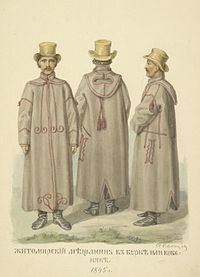

Kobeniak (Кобеняк) is a Ukrainian traditional male outer garment. Similar terms are Hungarian köpönyeg for "cloak", "mantle", "overcoat", and a historical Polish garment, kopieniak,[1] all terms being derived from the Turkish garment kepenek, which is a shepherd's garment. Kobeniak is also called burka (cf. "Burka (Caucasus)"), kireya, or siryak (бурка, кирея, сіряк).[2]
A kobenyak was the widest garment, so that it could be worn even on top of a kozhukh (fur coat). A distinctive feature is a hood which could cover nearly all the face, with a cut for the eyes and possibly for the mouth, which may be folded back.[2]
References
[edit]- ^ "Encyklopedia staropolska/Kopieniak - Wikiźródła, teksty i materiały źródłowe" (in Polish). Pl.wikisource.org. 2014-02-06. Retrieved 2014-02-17.
- ^ a b Вовк, Хведір. "Студії з української етнографії та антропології", Прага : Укр. громад. вид. фонд, [1916?] (Publ. «Легіографія»). — 354pp.
Well, that’s interesting to know that Psilotum nudum are known as whisk ferns. Psilotum nudum is the commoner species of the two. While the P. flaccidum is a rare species and is found in the tropical islands. Both the species are usually epiphytic in habit and grow upon tree ferns. These species may also be terrestrial and grow in humus or in the crevices of the rocks.
View the detailed Guide of Psilotum nudum: Detailed Study Of Psilotum Nudum (Whisk Fern), Classification, Anatomy, Reproduction